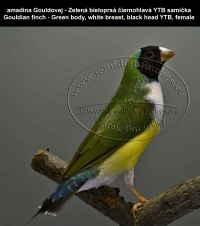Gouldian Finch Discovery
Gouldian Finch Discovery
At the end of March and beginning of April in 1839, Gouldian Finches were discovered by two members of French expedition in northern Australia, Hombron and Jacquinot. They were the first ones who named the species and assigned it a name Poephile Admirable. Hombron and Jacquinot were surgeons on two corvettes, L'Astrolabe and La Zelee that sailed from Toulon, France to examine South Pacific Ocean. They anchored at the north coast of Australia in Raffles Bay.
Black Headed and Red Headed Gouldian Finches ‒ 3 Red Headed and Black Headed birds were then killed during capture for scientific purposes (nowadays, we would certainly have a different opinion on this type of capture, even if for scientific purposes) but back then, the equipment did not enable detailed photographs or other documentation of the birds. Pictures of these birds (illustrations) were published in the atlas “Voyage au Pole Sud et dans l'Ocean sur les Corvettes L'Astrolabe et La Zelee”. Despite the effort, the expedition failed to find Yellow Headed birds and describe the behavior of the birds in their natural habitat.
Yellow Headed sort was captured by W. Armit in Four Mile Creek, Dunrobin near Georgetown, Northern Queensland. It was a female and was sent to a curator of the Australian Museum in Sydney who exhibited it at a meeting of a society from New South Wales in 1876.
Scientific description ‒ it was not until December 1839 when a Black Headed male was captured ‒ based on this, the very first scientific description of the species was performed by John Gould. It was provided by Benjamin Bynoe, an amateur biologist and surgeon in the navy.
 At that time, expeditions to Australia continued and after a visit of Greenhill Island located in Van Diemen Gulf in 1840, American John Gilbebrt managed to capture 2 juvenile Gouldians. J.Gilbert kept in touch with John Gould and was the first to describe certain characteristics of Gouldians’ behaviour in the wild to Gould.
At that time, expeditions to Australia continued and after a visit of Greenhill Island located in Van Diemen Gulf in 1840, American John Gilbebrt managed to capture 2 juvenile Gouldians. J.Gilbert kept in touch with John Gould and was the first to describe certain characteristics of Gouldians’ behaviour in the wild to Gould.
John McGillivray was another biologist who passed information about Gouldian Finches to John Gould. In his letter of May 1849, McGillivray informed Gould that after his arrival at the place where Gouldian Finches were supposed to occur he did not find any, because the birds migrated, but what he did find were 3 dead specimens. Later, he managed to get a few specimens himself when he found a small flock, but they were all very shy. As he described, the birds were in different stages of moult...
Origin of the name ‒ although Hombron and Jacquinot were the first to discover Gouldians, they were overtaken in a scientific description of the species. In 1845, a naturalist John Gould got all the glory by providing a scientific description of Gouldian Finches in his work “Proceedings of the Zoological Society of London” published in the previous year (in 1844). Gould´s description was based on a specimen provided by Benjamin Byone and 2 juveniles from J.Gilbert.
As J.Gould was the first who described the species he also got the privilege to name it. It was given a scientific name Amadina gouldiae. Subsequently, he reconsidered it and changed the name of the genus to Poephila. J.Gould was fascinated by Gouldians beauty and thus assigned them a specific epiteth in memory of his wife.
Since the discovery of this species, its name and also debates whether it is one species or not have often changed. More information can be found in the section on systematics and head colours.
11.03.2014 -

this website www.gouldianfinchces.eu
Contact:












